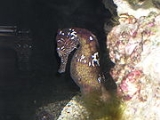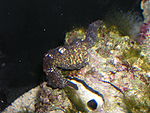
Hippocampus kuda
Encyclopedia
Hippocampus kuda, also known as the common seahorse, is a member of the family Syngnathidae
of the order Syngnathiformes
. The common sea horse is a small, equine-like fish, with extraordinary breeding methods. Greeks
and Romans
believed the seahorse was an attribute of the sea god Poseidon
/Neptune
, and the seahorse was considered a symbol of strength and power. Europeans
believed that the seahorse carried the souls of deceased sailors
to the underworld
- giving them safe passage and protection until they met their soul's destination. The common seahorse is considered a vulnerable species
.
oceans. Wild seahorse live mainly among coral reef
s, and shallow estuaries
. They use their tails to anchor themselves to coral
branches.
. Females are slightly smaller.
 Common seahorses have very small mouths, eating only small animals like brine shrimp
Common seahorses have very small mouths, eating only small animals like brine shrimp
and even newborn guppies
. Seahorses need to eat frequently—4-5 times a day. Many aquarists who have kept this species cultivate their own brine shrimp
, and rotifers. Daphnia
is eaten when other foods are unavailable.
Seahorses spend most of their time anchoring to coral reefs and branches with their tails, made necessary because they are poor swimmers. The need similar anchor points In aquaria. Seahorses like a quiet tank, without large, belligerent fish, and a slow-moving current. Aquarists have found them to be generally accepting of tankmates like Siniperca (Mandarin fish
) and other bottom dwelling fishes.
Their optimal pH range is around 8.1-8.4. The common seahorse can tolerate a range of salinity
from 18 parts per thousand (ppt) to 36 ppt but salinity below about 25ppt should be promptly corrected. About 32 ppt is ideal.
Syngnathidae
Syngnathidae is a family of fish which includes the seahorses, the pipefishes, and the weedy and leafy sea dragons. The name is derived from Greek, meaning "fused jaw" - syn meaning fused or together, and gnathus meaning jaws. This fused jaw trait is something the entire family has in common...
of the order Syngnathiformes
Syngnathiformes
Syngnathiformes is an order of ray-finned fishes that includes the pipefishes and seahorses.These fishes have elongate, narrow, bodies surrounded by a series of bony rings, and small, tubular mouths. Several groups live among seaweed and swim with the body aligned vertically, to blend in with the...
. The common sea horse is a small, equine-like fish, with extraordinary breeding methods. Greeks
Ancient Greece
Ancient Greece is a civilization belonging to a period of Greek history that lasted from the Archaic period of the 8th to 6th centuries BC to the end of antiquity. Immediately following this period was the beginning of the Early Middle Ages and the Byzantine era. Included in Ancient Greece is the...
and Romans
Ancient Rome
Ancient Rome was a thriving civilization that grew on the Italian Peninsula as early as the 8th century BC. Located along the Mediterranean Sea and centered on the city of Rome, it expanded to one of the largest empires in the ancient world....
believed the seahorse was an attribute of the sea god Poseidon
Poseidon
Poseidon was the god of the sea, and, as "Earth-Shaker," of the earthquakes in Greek mythology. The name of the sea-god Nethuns in Etruscan was adopted in Latin for Neptune in Roman mythology: both were sea gods analogous to Poseidon...
/Neptune
Neptune
Neptune is the eighth and farthest planet from the Sun in the Solar System. Named for the Roman god of the sea, it is the fourth-largest planet by diameter and the third largest by mass. Neptune is 17 times the mass of Earth and is slightly more massive than its near-twin Uranus, which is 15 times...
, and the seahorse was considered a symbol of strength and power. Europeans
Europe
Europe is, by convention, one of the world's seven continents. Comprising the westernmost peninsula of Eurasia, Europe is generally 'divided' from Asia to its east by the watershed divides of the Ural and Caucasus Mountains, the Ural River, the Caspian and Black Seas, and the waterways connecting...
believed that the seahorse carried the souls of deceased sailors
Sailors
Sailors is the plural form of Sailor, or mariner.Sailors may also refer to:*Sailors , a 1964 Swedish film*Ken Sailors , American basketball playerSports teams*Erie Sailors, baseball teams in Pennsylvania, USA...
to the underworld
Underworld
The Underworld is a region which is thought to be under the surface of the earth in some religions and in mythologies. It could be a place where the souls of the recently departed go, and in some traditions it is identified with Hell or the realm of death...
- giving them safe passage and protection until they met their soul's destination. The common seahorse is considered a vulnerable species
Vulnerable species
On 30 January 2010, the IUCN Red List of Threatened Species identified 9694 Vulnerable species, subspecies and varieties, stocks and sub-populations.-References:...
.
Reproduction
The male carries the eggs in a brood pouch on his lower abdomen. After courtship the pair come close together so that the female's oviduct is close to, if not resting on, the brood pouch of the male, and the female expels some eggs into the pouch. This happens several times until spawning is complete. The male then wiggles about, as if to rearrange the eggs within his pouch. The exact point at which fertilization takes place is not known, though many assume that it occurs while the eggs are in the pouch. The incubation period is generally four to five weeks. To "give birth" the male bends forwards and then backwards, thrusting his pouch forward expelling one or two youngsters with explosive force. Raising the fry in an aquarium is difficult, as they require a large amount of minuscule live food.Range and habitat
The common seahorse inhabits shallow coastal waters throughout the Indo-PacificIndo-Pacific
The Indo-Pacific is a biogeographic region of the Earth's seas, comprising the tropical waters of the Indian Ocean, the western and central Pacific Ocean, and the seas connecting the two in the general area of Indonesia...
oceans. Wild seahorse live mainly among coral reef
Coral reef
Coral reefs are underwater structures made from calcium carbonate secreted by corals. Coral reefs are colonies of tiny living animals found in marine waters that contain few nutrients. Most coral reefs are built from stony corals, which in turn consist of polyps that cluster in groups. The polyps...
s, and shallow estuaries
Estuary
An estuary is a partly enclosed coastal body of water with one or more rivers or streams flowing into it, and with a free connection to the open sea....
. They use their tails to anchor themselves to coral
Coral
Corals are marine animals in class Anthozoa of phylum Cnidaria typically living in compact colonies of many identical individual "polyps". The group includes the important reef builders that inhabit tropical oceans and secrete calcium carbonate to form a hard skeleton.A coral "head" is a colony of...
branches.
Physical description
The sea horse's swimming position is vertical, with slight forward or backward inclinations, in the direction of travel. The body is covered with armored plates. An equine-like head set at right angles to the body ends in a long tubular snout. A bony "coronet" may develop on the head. The male seahorse broods fertilized eggs in a small pouch in its lower abdomenAbdomen
In vertebrates such as mammals the abdomen constitutes the part of the body between the thorax and pelvis. The region enclosed by the abdomen is termed the abdominal cavity...
. Females are slightly smaller.
In aquaria

Brine shrimp
Artemia is a genus of aquatic crustaceans known as brine shrimp. Artemia, the only genus in the family Artemiidae, has changed little externally since the Triassic period...
and even newborn guppies
Guppy
The guppy , also known as the millionfish, is one of the most popular freshwater aquarium fish species in the world. It is a small member of the Poeciliidae family [females long, males long] and like all other members of the family, is live-bearing....
. Seahorses need to eat frequently—4-5 times a day. Many aquarists who have kept this species cultivate their own brine shrimp
Brine shrimp
Artemia is a genus of aquatic crustaceans known as brine shrimp. Artemia, the only genus in the family Artemiidae, has changed little externally since the Triassic period...
, and rotifers. Daphnia
Daphnia
Daphnia are small, planktonic crustaceans, between 0.2 and 5 mm in length. Daphnia are members of the order Cladocera, and are one of the several small aquatic crustaceans commonly called water fleas because of their saltatory swimming style...
is eaten when other foods are unavailable.
Seahorses spend most of their time anchoring to coral reefs and branches with their tails, made necessary because they are poor swimmers. The need similar anchor points In aquaria. Seahorses like a quiet tank, without large, belligerent fish, and a slow-moving current. Aquarists have found them to be generally accepting of tankmates like Siniperca (Mandarin fish
Mandarin fish
The mandarin fish or Chinese perch is a freshwater fish that lives in China. Its back is yellow, green or brown with many irregular black spots and patches. It has a big mouth and small round scales. Mandarin fish live in still water and move to deep water in winter...
) and other bottom dwelling fishes.
Temperature, pH, and salinity
Common seahorse generally do best at a temperature of 72–77 °F (22.2–25 C), optimally 73–75 °F (22.8–23.9 C). They do not tolerate even spikes above 80 °F (26.7 °C) well.Their optimal pH range is around 8.1-8.4. The common seahorse can tolerate a range of salinity
Salinity
Salinity is the saltiness or dissolved salt content of a body of water. It is a general term used to describe the levels of different salts such as sodium chloride, magnesium and calcium sulfates, and bicarbonates...
from 18 parts per thousand (ppt) to 36 ppt but salinity below about 25ppt should be promptly corrected. About 32 ppt is ideal.

